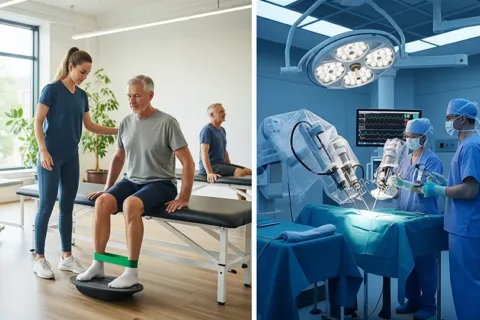Table of Contents
Introduction
Lower back pain is something that affects millions of people every day. Whether it’s a nagging, constant ache or a sharp, sudden pain that makes it hard to move, this discomfort can really get in the way of your daily life. It can make simple tasks, whether at work or home, feel almost impossible. Usually, this pain comes from poor posture, not enough exercise, or injuries. If it’s not treated properly, it can become a long-term issue.

Physiotherapy is a great way to deal with lower back pain because it targets the root of the problem rather than just masking the symptoms with medication. Through specific exercises and techniques, physiotherapy helps to strengthen your muscles, improve your flexibility, and get your lower back working properly again. This approach doesn’t just help with pain relief; it also helps prevent future problems by addressing what’s causing the pain in the first place.
The exercises in physiotherapy are aimed at stretching and strengthening the muscles that support your spine, improving your posture, and increasing your overall mobility. They are tailored to fit your unique situation, taking into account the cause of your pain, your overall health, and your fitness level. By sticking with these exercises, you can find long-term relief from lower back pain and improve your quality of life.

In this guide, we’ll walk you through everything you need to know about lower back pain, from understanding why it happens to the best physiotherapy exercises to try. Whether you’re dealing with occasional or chronic pain, you’ll find helpful information and practical solutions to help you manage and overcome your discomfort. Let’s explore how physiotherapy can help you take control of your back health.
Overview of Lower Back Pain
Lower back pain is a pervasive issue that affects people of all ages and backgrounds. It is one of the leading causes of disability worldwide and can range from a mild, nagging discomfort to severe, debilitating pain that hinders daily activities. The lower back, or lumbar region, supports the upper body’s weight and is involved in almost every movement, making it particularly vulnerable to injury and strain.
Several factors contribute to lower back pain, including lifestyle habits, physical activity levels, and underlying health conditions. Poor posture, prolonged sitting, and improper lifting techniques are common causes of muscle strain and tension in the lower back. Additionally, obesity and lack of exercise can weaken the muscles supporting the spine, leading to an increased risk of pain and injury.

Lower back pain can be classified into two main categories: acute and chronic. Acute lower back pain typically lasts for a few days to a few weeks and is often the result of a specific incident, such as lifting something heavy or a sudden awkward movement. Chronic lower back pain, on the other hand, persists for 12 weeks or longer and may stem from conditions like degenerative disc disease, arthritis, or sciatica.
The impact of lower back pain extends beyond physical discomfort. It can affect mental health, leading to stress, anxiety, and depression. Moreover, the limitations imposed by lower back pain can hinder one’s ability to work, exercise, and enjoy daily life, creating a cycle of pain and decreased quality of life.
Understanding the various causes and impacts of lower back pain is the first step toward effective management. By identifying the underlying issues and adopting preventive measures, individuals can reduce the likelihood of experiencing lower back pain and maintain a healthier, more active lifestyle.
Role of Physiotherapy in Managing Back Pain
Physiotherapy plays a critical role in the management and treatment of lower back pain. Unlike pain medications, which merely mask the symptoms, physiotherapy aims to address the root causes of the pain, providing long-term relief and improving overall back health. Through a combination of exercises, manual therapy, and patient education, physiotherapy helps restore function, reduce pain, and prevent future episodes of back pain.
One of the primary goals of physiotherapy is to strengthen the muscles that support the spine. Weak or imbalanced muscles can place undue stress on the spine, leading to pain and injury. Physiotherapists design individualized exercise programs that target specific muscle groups, enhancing their strength and endurance. These exercises not only alleviate pain but also improve posture, stability, and flexibility, which are essential for a healthy back.

Another important aspect of physiotherapy is improving mobility. Lower back pain often leads to stiffness and reduced range of motion, making it difficult to perform everyday tasks. Physiotherapy techniques, such as stretching exercises and manual therapy, help increase flexibility and joint mobility, allowing for more fluid and pain-free movement. By addressing these mobility issues, physiotherapy enables patients to regain their independence and engage in activities they may have previously avoided due to pain.
Patient education is also a key component of physiotherapy. Physiotherapists teach patients how to maintain proper posture, use correct lifting techniques, and incorporate healthy movement patterns into their daily lives. This knowledge empowers patients to take control of their back health and reduces the risk of future injuries.
Overall, physiotherapy offers a holistic and proactive approach to managing lower back pain. By focusing on the underlying causes and providing patients with the tools they need to maintain a healthy back, physiotherapy helps individuals achieve long-term relief and improve their quality of life.
Understanding Lower Back Pain
Lower back pain is a complex condition that can arise from various factors. It is one of the most common reasons people seek medical attention, and it can be both acute and chronic. Understanding the causes and mechanisms behind lower back pain is crucial to effectively managing and treating it. This section will delve into the anatomy of the lower back, common causes of pain, and the symptoms that indicate when professional help is needed.
The lower back, or lumbar region, consists of five vertebrae labelled L1 to L5, which are the largest and strongest in the spine. These vertebrae support the majority of your body’s weight and allow for a wide range of movements, such as bending, twisting, and lifting. The lumbar spine is also cushioned by intervertebral discs, which act as shock absorbers, and is surrounded by muscles, ligaments, and nerves that contribute to its stability and function.

Given the complexity of this region, it’s no surprise that the lower back is susceptible to injury and pain. Poor posture, repetitive stress, and improper lifting techniques can all strain the muscles and ligaments in the lower back, leading to discomfort and pain. Additionally, conditions like herniated discs, spinal stenosis, and degenerative disc disease can cause chronic lower back pain that requires ongoing management.
Recognizing the symptoms of lower back pain is essential for determining the appropriate course of action. While mild discomfort may resolve on its own with rest and over-the-counter pain relievers, persistent or severe pain could indicate a more serious issue. Symptoms like numbness, tingling, or weakness in the legs, difficulty walking, or loss of bladder or bowel control require immediate medical attention, as they could signal nerve compression or other complications.
In the following sections, we will explore the anatomy of the lower back in more detail, discuss common causes of lower back pain, and outline the symptoms that should prompt you to seek medical help. Understanding these factors will provide a solid foundation for addressing and managing lower back pain effectively.
Anatomy of the Lower Back
The lower back, also known as the lumbar region, plays a crucial role in supporting the weight of the upper body and enabling a wide range of movements. Understanding the anatomy of the lower back is essential for grasping how pain can develop and how it can be effectively treated.
The lumbar spine consists of five vertebrae, labelled L1 to L5, which are larger and more robust than the vertebrae in other parts of the spine. These vertebrae are stacked on top of one another and separated by intervertebral discs, which serve as cushions or shock absorbers between the bones. These discs are made up of a tough outer layer, called the annulus fibrosus, and a gel-like centre, called the nucleus pulposus. The discs allow the spine to be flexible and absorb the impacts from activities like walking, running, or lifting.
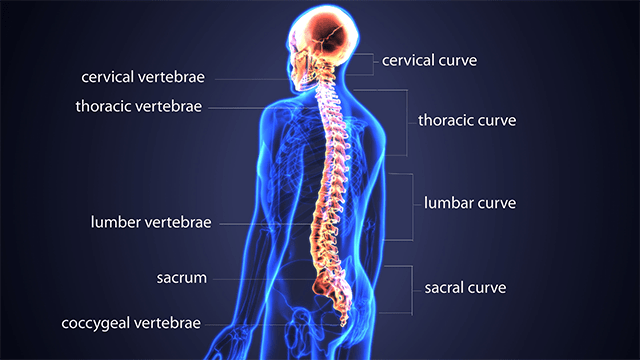
In addition to the bones and discs, the lower back is supported by a network of muscles, ligaments, and tendons. The muscles in the lumbar region can be categorized into two main groups: the deep muscles, which stabilize the spine, and the superficial muscles, which enable movement. The deep muscles, such as the multifidus and the erector spinae, are particularly important for maintaining posture and stability. The superficial muscles, like the latissimus dorsi and the quadratus lumborum, contribute to bending, twisting, and other dynamic movements.
The lower back also houses important nerves, including the sciatic nerve, which runs from the lower spine down the legs. These nerves control the muscles of the lower back and legs and convey sensations from the lower body to the brain. When these nerves are compressed or irritated, it can lead to pain, numbness, or weakness in the back and legs, a condition known as sciatica.
Given the complexity of the lower back’s structure and function, it’s easy to see why it is prone to injury and pain. The interaction between bones, discs, muscles, and nerves must be finely balanced to maintain a healthy back. Disruption to this balance—whether due to injury, poor posture, or degenerative changes—can lead to discomfort or chronic pain. Understanding this anatomy is the first step in addressing lower back pain effectively through targeted treatments like physiotherapy.
Common Causes of Lower Back Pain
Lower back pain can be triggered by a wide variety of factors, ranging from simple muscle strains to more complex spinal conditions. Understanding the common causes of lower back pain can help in identifying the source of discomfort and determining the most effective treatment approach.
One of the most frequent causes of lower back pain is muscle strain. This can occur when the muscles or ligaments in the lower back are overstretched or torn, often due to sudden movements, heavy lifting, or poor posture. Muscle strain can lead to inflammation and pain, which may be acute and short-lived, or it can develop into chronic pain if not properly managed.

Poor posture is another leading cause of lower back pain. Many people spend long hours sitting at desks, hunched over computers or mobile devices. This prolonged poor posture puts extra strain on the muscles and ligaments of the lower back, leading to tension and discomfort. Over time, this can contribute to misalignment of the spine and chronic pain.
Herniated discs are a more severe cause of lower back pain. A herniated disc occurs when the soft inner material of an intervertebral disc pushes through the tough outer layer, pressing on nearby nerves. This can cause significant pain, as well as numbness, tingling, or weakness in the legs, a condition known as sciatica. Disc herniation is often a result of aging, as the discs lose their flexibility and resilience over time, but it can also be caused by injury or improper lifting.
Degenerative disc disease is another common cause of lower back pain, particularly in older adults. This condition involves the gradual breakdown of the intervertebral discs, leading to reduced cushioning between the vertebrae. As the discs degenerate, they lose their ability to absorb shock, resulting in increased friction between the bones and chronic pain.
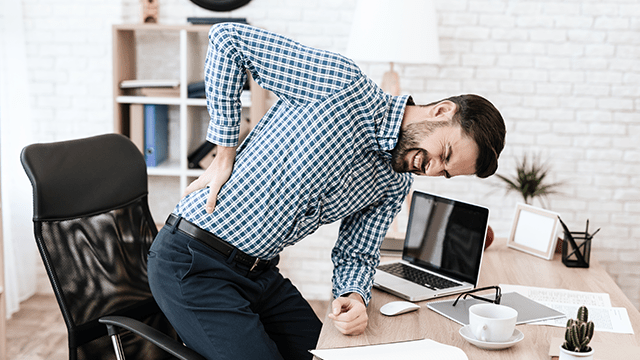
Other causes of lower back pain include spinal stenosis, where the spinal canal narrows and compresses the nerves, and conditions like osteoarthritis and scoliosis, which can alter the spine’s normal curvature and function. Additionally, lifestyle factors such as obesity, lack of exercise, and smoking can exacerbate lower back pain by weakening the muscles that support the spine and reducing blood flow to the discs.
Understanding the common causes of lower back pain is essential for effective treatment. By identifying the specific source of pain, individuals can work with healthcare professionals to develop targeted strategies to manage and alleviate their symptoms.
Symptoms and When to Seek Medical Attention
Lower back pain can manifest in a variety of ways, ranging from mild discomfort to severe, debilitating pain. Recognizing the symptoms and understanding when to seek medical attention is crucial for preventing the condition from worsening and for ensuring appropriate treatment.
Common symptoms of lower back pain include a dull, aching pain that may be localized to one area or spread across the lower back. This pain can be accompanied by stiffness, making it difficult to move or bend. In some cases, the pain may radiate down the buttocks and legs, especially if a nerve is compressed or irritated. This type of radiating pain is often associated with sciatica, where the sciatic nerve is affected, leading to sharp, shooting pain down one leg.
Another symptom to watch for is muscle spasms. These involuntary contractions of the muscles in the lower back can be extremely painful and may occur after a sudden movement, lifting something heavy, or even just standing up after sitting for a long period. Muscle spasms can cause the lower back to feel tight and knotted, further limiting mobility.
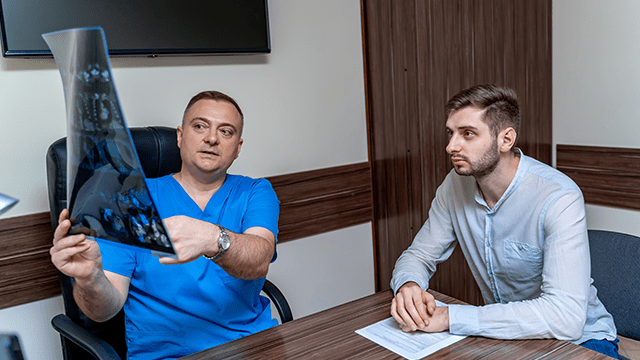
In more severe cases, lower back pain can be accompanied by neurological symptoms such as numbness, tingling, or weakness in the legs. These symptoms may indicate nerve involvement and require immediate medical attention. Additionally, if lower back pain is accompanied by loss of bladder or bowel control, it could be a sign of a serious condition known as cauda equina syndrome, which is a medical emergency.
It is important to seek medical attention if lower back pain is severe, persistent, or accompanied by the aforementioned symptoms. While mild lower back pain can often be managed with rest, over-the-counter pain relievers, and home exercises, more serious cases require professional evaluation. A healthcare provider can conduct a thorough assessment, including physical exams and imaging studies like X-rays or MRIs, to determine the underlying cause of the pain.
In summary, while lower back pain is common and often not a cause for concern, it’s crucial to recognize when the pain might be signalling a more serious issue. Seeking timely medical attention can prevent complications, facilitate proper treatment, and help individuals get back to their normal activities as quickly as possible.
Preparation Before Starting Exercises
Before diving into physiotherapy exercises for lower back pain, it’s important to take some preparatory steps to ensure that the exercises are both safe and effective. Proper preparation can help maximize the benefits of your exercise routine while minimizing the risk of injury or exacerbating existing pain. This section will cover the importance of warming up, maintaining proper posture and alignment, and consulting with a physiotherapist before starting any exercise program.
Importance of Warming Up
Warming up is a critical first step before beginning any exercise routine, especially when dealing with lower back pain. A proper warm-up prepares your body for the physical activity to come by gradually increasing your heart rate, improving blood flow to the muscles, and enhancing the flexibility of your joints. This process helps to reduce the risk of injury and ensures that your muscles are ready to work efficiently during your exercise session.
When you warm up, the temperature of your muscles rises, which makes them more pliable and less prone to strains or tears. This is particularly important for the muscles in the lower back, which are often tight and inflexible in people with lower back pain. A warm-up also helps to lubricate the joints, reducing friction and stiffness, which can improve your range of motion and make it easier to perform the exercises correctly.

A good warm-up for lower back exercises should last about 5 to 10 minutes and include activities that gently engage the muscles and joints of the lower body. For example, you can start with light aerobic activities such as walking or cycling at a slow pace. These activities get your blood flowing and gradually increase your heart rate, preparing your body for more intense exercises.
After the aerobic portion of your warm-up, it’s beneficial to include dynamic stretching exercises that target the lower back and surrounding muscle groups. Dynamic stretches involve controlled movements that gently take your muscles through their full range of motion. Examples include gentle torso twists, leg swings, and hip circles. These movements help to loosen up the muscles and increase flexibility, which can reduce the likelihood of straining your back during the main exercise routine.
Skipping the warm-up can leave your muscles cold and stiff, increasing the risk of injury and reducing the effectiveness of your workout. By taking the time to warm up properly, you’re setting the stage for a successful exercise session that can help alleviate lower back pain and improve your overall back health.
Proper Posture and Alignment
Maintaining proper posture and alignment during physiotherapy exercises is crucial for preventing further injury and ensuring the exercises effectively target the intended muscles. Poor posture can place additional strain on the lower back, exacerbating pain and potentially leading to other issues over time. Understanding and practicing good posture can make a significant difference in the success of your physiotherapy routine.
Proper posture begins with the alignment of your spine. The spine has three natural curves: the cervical curve in the neck, the thoracic curve in the upper back, and the lumbar curve in the lower back. When standing or sitting, these curves should be maintained in a neutral position, where the spine is not overly arched or flattened. This neutral alignment helps to evenly distribute your body’s weight and reduces the stress on any one part of the spine.
When performing exercises for lower back pain, it’s important to keep your spine in this neutral position. For example, when doing core exercises like planks or bridges, you should avoid letting your lower back sag or excessively arch. Instead, engage your abdominal muscles to support the spine and keep it in a straight line. This not only protects your lower back but also ensures that the right muscles are being activated during the exercise.
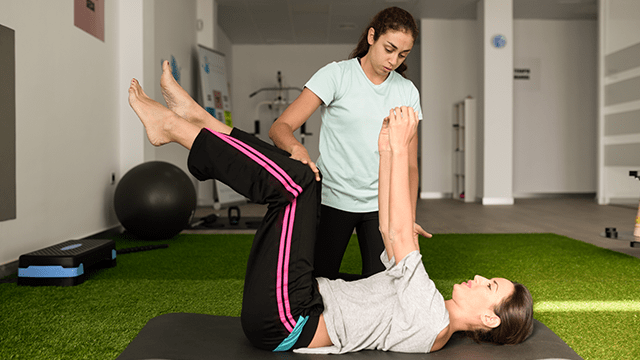
In addition to spinal alignment, attention should also be paid to the positioning of other body parts. For instance, when lifting weights or performing squats, your knees should be aligned with your toes, and your shoulders should be relaxed and back. Keeping your shoulders back and down, away from your ears, helps to avoid unnecessary tension in the neck and upper back, which can indirectly affect your lower back.
Posture is also important during daily activities outside of your exercise routine. Sitting for long periods with poor posture, such as slouching or leaning forward, can lead to tightness and pain in the lower back. To counteract this, try to sit with your feet flat on the floor, your back straight, and your shoulders relaxed. When standing, distribute your weight evenly between both feet and avoid locking your knees.
Practicing proper posture and alignment not only helps to alleviate lower back pain but also contributes to better overall body mechanics, reducing the risk of injury during exercise and everyday activities.
Consulting a Physiotherapist
Before starting any exercise routine, especially if you are dealing with lower back pain, it’s highly recommended to consult with a physiotherapist. A physiotherapist is a healthcare professional who specializes in the movement and function of the body and can provide expert guidance on the most appropriate exercises for your specific condition. Consulting a physiotherapist ensures that your exercise program is tailored to your needs and helps to avoid exercises that could potentially worsen your pain.
One of the key benefits of consulting a physiotherapist is that they can perform a comprehensive assessment of your condition. This assessment typically includes an evaluation of your posture, range of motion, strength, and any specific areas of pain or discomfort. The physiotherapist may also inquire about your medical history, lifestyle habits, and any previous injuries. Based on this information, they can develop a personalized exercise plan that targets the root cause of your lower back pain and promotes recovery.
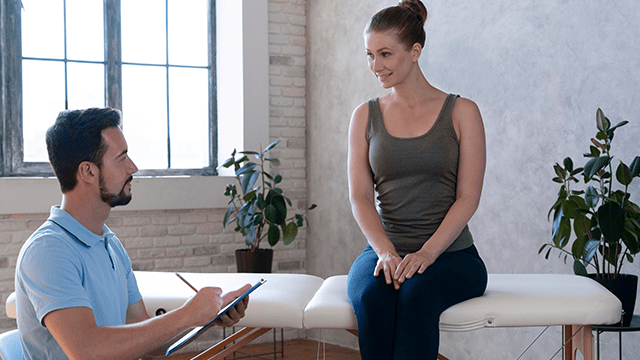
Physiotherapists can also educate you on proper exercise techniques. Even the most beneficial exercises can cause harm if performed incorrectly. A physiotherapist can demonstrate the correct form and provide hands-on guidance to ensure that you are doing the exercises safely and effectively. They can also modify exercises to suit your current fitness level and gradually increase the intensity as your strength and flexibility improve.
In addition to prescribing exercises, physiotherapists may use other treatment modalities to complement your exercise routine. These may include manual therapy techniques, such as massage or joint mobilization, to relieve pain and improve mobility. They may also provide advice on ergonomic adjustments to your work or home environment to prevent further strain on your lower back.
Moreover, a physiotherapist can monitor your progress over time and make adjustments to your exercise program as needed. If you are not seeing the desired results or if your pain persists, the physiotherapist can reassess your condition and make necessary changes to your treatment plan.
Overall, consulting a physiotherapist before starting a lower back exercise routine is a proactive step that can help you achieve the best possible outcomes. With their expertise, you can confidently begin your exercises knowing that you are taking the right steps toward alleviating your lower back pain and improving your overall quality of life.
Top 20 Physiotherapy Exercises for Lower Back Pain
Physiotherapy exercises are a cornerstone of managing and alleviating lower back pain. These exercises are designed to strengthen the muscles that support the spine, improve flexibility, and reduce tension in the lower back. By regularly performing these exercises, individuals can relieve pain, enhance mobility, and prevent future episodes of back discomfort. Below, we will explore 20 effective physiotherapy exercises for lower back pain, divided into categories based on their primary benefits: strengthening, stretching, and mobilizing the lower back.
Strengthening Exercises
Strengthening the muscles of the lower back and core is crucial for providing adequate support to the spine. These exercises focus on building endurance and stability in the muscles that help maintain proper posture and alignment.
1. Pelvic Tilts
Pelvic tilts are a gentle exercise that helps to strengthen the abdominal muscles and improve the flexibility of the lower back. To perform a pelvic tilt:

- Lie on your back with your knees bent and feet flat on the floor.
- Tighten your abdominal muscles, pressing your lower back into the floor.
- Hold the position for 5 seconds, then relax.
- Repeat 10-15 times.
Pelvic tilts are particularly useful for relieving pain associated with lower back stiffness and for enhancing core stability.
2. Bridges
Bridges are an excellent exercise for strengthening the gluteal muscles, hamstrings, and lower back. To perform a bridge:

- Lie on your back with your knees bent and feet flat on the floor, hip-width apart.
- Tighten your abdominal muscles and lift your hips towards the ceiling, creating a straight line from your shoulders to your knees.
- Hold the position for 5-10 seconds, then slowly lower your hips back to the floor.
- Repeat 10-15 times.
Bridges help to build strength in the posterior chain, which includes the muscles along the back of your body, providing better support for the spine.
3. Bird-Dog
The bird-dog exercise improves balance, coordination, and core strength by engaging multiple muscle groups simultaneously. To perform a bird-dog:

- Start on your hands and knees, with your hands directly under your shoulders and your knees under your hips.
- Extend your right arm forward and your left leg straight back, keeping both parallel to the floor.
- Hold for a few seconds, then return to the starting position.
- Repeat with the opposite arm and leg.
- Perform 10-15 repetitions on each side.
The bird-dog exercise helps stabilize the lower back by engaging the core and lower back muscles.
4. Plank
The plank is a well-known core exercise that strengthens the muscles of the abdomen, lower back, and shoulders. To perform a plank:

- Start in a push-up position, with your forearms on the floor and your body in a straight line from head to heels.
- Tighten your abdominal muscles and hold the position for 20-30 seconds.
- Gradually increase the duration as your strength improves.
Planks help build endurance in the core and lower back muscles, which are essential for maintaining good posture.
5. Side Plank
Side planks target the oblique muscles, which are important for supporting the sides of the lower back. To perform a side plank:

- Lie on your side with your legs extended and stacked on top of each other.
- Prop yourself up on your forearm, keeping your body in a straight line from head to feet.
- Hold the position for 20-30 seconds, then switch sides.
- Repeat 2-3 times on each side.
Side planks strengthen the lateral core muscles, helping to reduce strain on the lower back.
6. Dead Bug
The dead bug exercise is excellent for improving core stability without putting excessive strain on the lower back. To perform a dead bug:
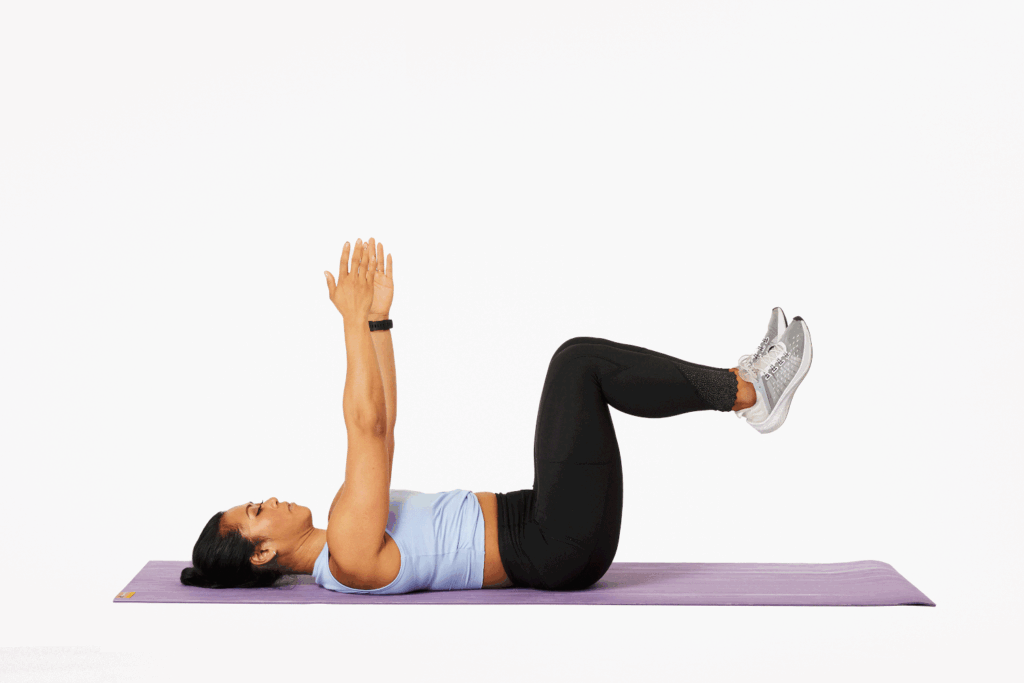
- Lie on your back with your arms extended toward the ceiling and your knees bent at a 90-degree angle.
- Slowly lower your right arm and left leg towards the floor while keeping your lower back pressed into the ground.
- Return to the starting position and repeat with the opposite arm and leg.
- Perform 10-15 repetitions on each side.
The dead bug exercise helps to strengthen the core while maintaining proper spinal alignment.
7. Superman
The superman exercise targets the lower back, glutes, and hamstrings. To perform a superman:

- Lie face down on the floor with your arms extended in front of you and your legs straight.
- Simultaneously lift your arms, chest, and legs off the ground as high as you can.
- Hold the position for 2-3 seconds, then slowly lower back down.
- Repeat 10-15 times.
Superman exercises help to strengthen the muscles along the spine and improve lower back stability.
Stretching Exercises
Stretching exercises help to improve flexibility, relieve tension, and increase the range of motion in the lower back. These exercises are particularly useful for reducing stiffness and preventing injury.
8. Knee-to-Chest Stretch
The knee-to-chest stretch gently stretches the muscles of the lower back and relieves tension. To perform this stretch:

- Lie on your back with your knees bent and feet flat on the floor.
- Slowly bring one knee towards your chest, clasping your hands around it.
- Hold the stretch for 15-30 seconds, then switch legs.
- Repeat 2-3 times on each side.
This stretch helps to lengthen the lower back muscles and alleviate discomfort.
9. Child’s Pose
Child’s pose is a yoga stretch that relaxes the lower back and hips. To perform child’s pose:
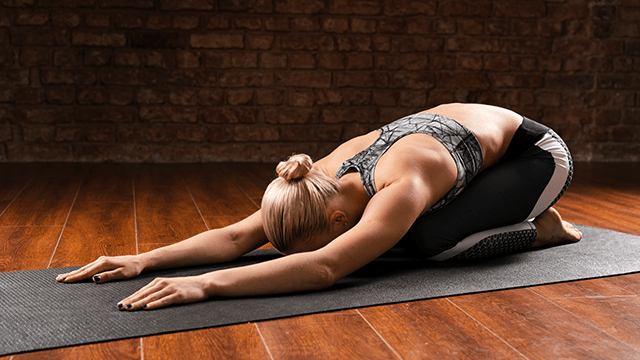
- Kneel on the floor with your big toes touching and knees spread apart.
- Sit back on your heels and stretch your arms forward, lowering your forehead to the floor.
- Hold the stretch for 30 seconds to 1 minute.
Child’s pose helps to stretch the lower back and decompress the spine, providing relief from tension.
10. Cat-Cow Stretch
The cat-cow stretch is a gentle exercise that promotes flexibility in the spine. To perform the cat-cow stretch:


- Start on your hands and knees, with your hands directly under your shoulders and your knees under your hips.
- Inhale and arch your back, lifting your head and tailbone towards the ceiling (cow pose).
- Exhale and round your back, tucking your chin to your chest and tailbone under (cat pose).
- Repeat the sequence 10-15 times.
This dynamic stretch helps to improve mobility and relieve stiffness in the lower back.
11. Piriformis Stretch
The piriformis stretch targets the piriformis muscle, which can contribute to lower back pain if tight. To perform this stretch:
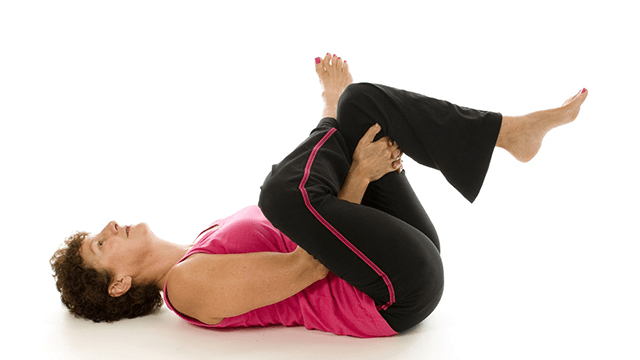
- Lie on your back with your knees bent and feet flat on the floor.
- Cross one ankle over the opposite knee, forming a figure-four shape.
- Gently pull the bottom leg towards your chest, feeling the stretch in your buttocks and lower back.
- Hold for 15-30 seconds, then switch sides.
The piriformis stretch helps to relieve tension in the lower back and hips.
12. Seated Forward Bend
The seated forward bend stretch elongates the hamstrings and lower back muscles. To perform this stretch:
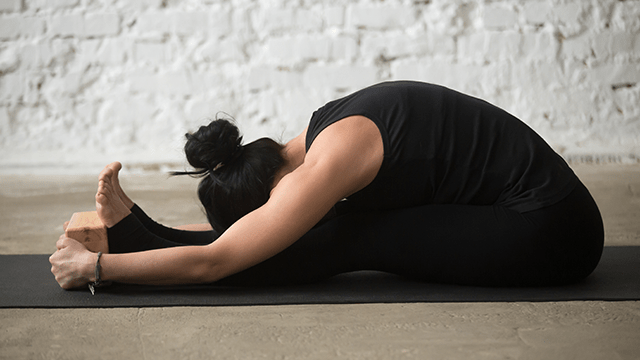
- Sit on the floor with your legs extended straight in front of you.
- Inhale and lengthen your spine, then exhale as you reach forward towards your toes.
- Hold the stretch for 15-30 seconds, maintaining a straight back.
This stretch helps to reduce tension in the lower back and improve flexibility.
13. Cobra Stretch
The cobra stretch is another yoga pose that helps to stretch the lower back and open up the chest. To perform the cobra stretch:

- Lie face down on the floor with your hands placed under your shoulders.
- Slowly press your hands into the floor, lifting your chest while keeping your hips grounded.
- Hold the position for 10-20 seconds, then lower back down.
The cobra stretch helps to extend the spine and relieve lower back tension.
14. Hip Flexor Stretch
Tight hip flexors can contribute to lower back pain, making this stretch particularly beneficial. To perform a hip flexor stretch:
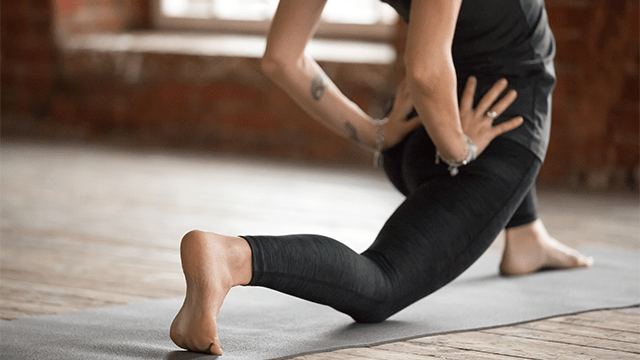
- Start in a lunge position with one foot forward and the other knee on the ground.
- Shift your weight forward, feeling a stretch in the front of the hip of the back leg.
- Hold the stretch for 15-30 seconds, then switch sides.
This stretch helps to alleviate lower back pain by loosening tight hip flexors.
Mobilizing Exercises
Mobilizing exercises help to improve the range of motion in the lower back and hips, which can be restricted due to pain or stiffness. These exercises promote fluid movement and reduce the likelihood of injury.
15. Lumbar Rotation Stretch
The lumbar rotation stretch improves the flexibility of the lower back and spine. To perform this stretch:
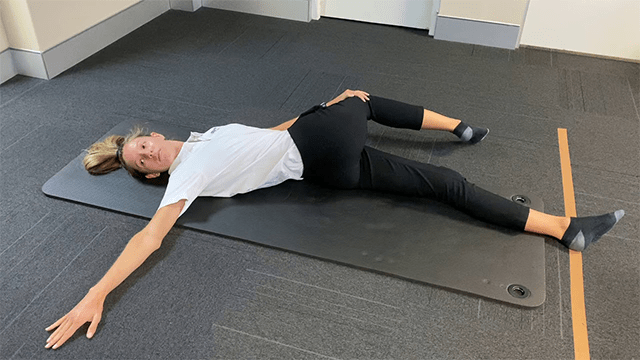
- Lie on your back with your knees bent and feet flat on the floor.
- Gently drop your knees to one side while keeping your shoulders flat on the floor.
- Hold the stretch for 15-30 seconds, then switch sides.
This stretch helps to mobilize the lower back and reduce stiffness.
16. Pelvic Clock Exercise
To perform the pelvic clock exercise:
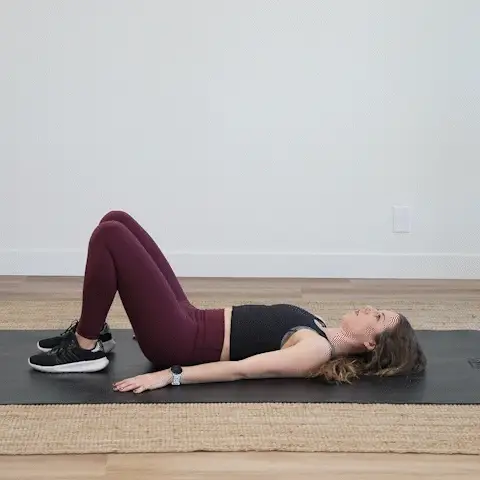
- Position: Lie on your back with your knees bent and feet flat on the floor. Place your hands on your hips for feedback on movement.
- Movement: Imagine your pelvis as the face of a clock. Tilt your pelvis towards 12 o’clock by arching your lower back and pressing your tailbone down. Then, tilt towards 6 o’clock by flattening your lower back against the floor. Continue to move your pelvis in a circular motion, going through the positions of 3 o’clock and 9 o’clock as well.
- Repetitions: Perform the circular motion for about 1-2 minutes, changing direction halfway through.
This exercise enhances the mobility of the pelvis and lower back, promoting better spinal alignment and reducing stiffness.
17. Knee Rolls
Knee rolls are a simple yet effective exercise for improving lower back mobility. To perform knee rolls:
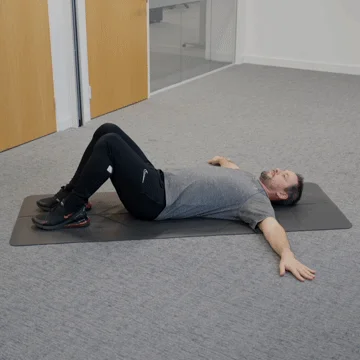
- Position: Lie on your back with your knees bent and feet flat on the floor.
- Movement: Keeping your shoulders relaxed on the floor, gently roll your knees to one side as far as comfortable. Hold the position for a few seconds and then return to the starting position. Repeat by rolling your knees to the other side.
- Repetitions: Perform 10-15 rolls on each side.
Knee rolls help to increase the rotational mobility of the lower back and alleviate tension.
18. Standing Hamstring Stretch
The standing hamstring stretch targets the hamstrings and lower back, helping to improve flexibility and reduce tension. To perform this stretch:

- Position: Stand with your feet hip-width apart. Extend one leg forward and place the heel on a low surface such as a chair or step.
- Movement: Keeping your back straight, lean forward from your hips towards the extended leg. You should feel a stretch along the back of your thigh and lower back.
- Hold: Maintain the stretch for 15-30 seconds, then switch legs.
- Repetitions: Repeat 2-3 times on each side.
This stretch alleviates tightness in the hamstrings and lower back, enhancing overall flexibility.
19. Cat-Cow Stretch
The cat-cow stretch improves flexibility and mobilizes the spine. To perform this stretch:

- Position: Start on your hands and knees, with your wrists directly under your shoulders and knees under your hips.
- Movement: Inhale as you arch your back, lifting your head and tailbone towards the ceiling (cow position). Exhale as you round your back, tucking your chin to your chest and drawing your belly button towards your spine (cat position).
- Repetitions: Perform the stretch for 1-2 minutes, moving fluidly between the two positions.
This stretch helps to warm up and mobilize the spine, reducing stiffness in the lower back.
20. Hip Circles
Hip circles enhance the mobility of the hip joints, which can affect the lower back. To perform hip circles:
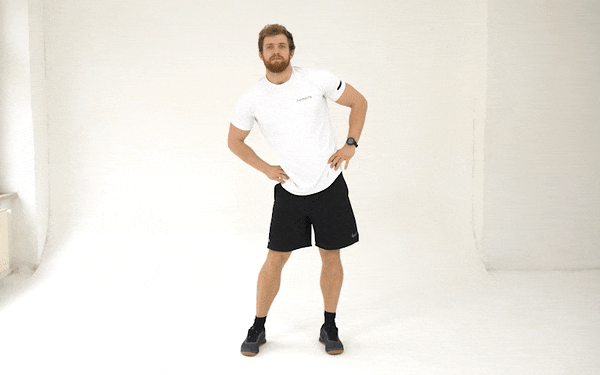
- Position: Stand with your feet hip-width apart and place your hands on your hips.
- Movement: Gently move your hips in a circular motion, making large circles. Perform the circles in one direction for about 30 seconds, then switch to the opposite direction.
- Repetitions: Perform 2-3 sets in each direction.
Hip circles help to improve the range of motion in the hips and lower back, reducing tension and promoting flexibility.
These 20 exercises cover a range of strengthening, stretching, and mobilizing techniques that can effectively address lower back pain. Incorporating these exercises into your routine can help alleviate discomfort, enhance flexibility, and build strength in the muscles supporting the spine. It is important to perform these exercises consistently and to consult with a healthcare professional or physiotherapist to ensure that they are appropriate for your specific condition. Regular practice, combined with proper technique and posture, can lead to significant improvements in lower back health and overall well-being.
Tips for Maximizing the Benefits of Physiotherapy
How to Incorporate Exercises into Your Daily Routine
Incorporating physiotherapy exercises into your daily routine is essential for effectively managing lower back pain and achieving long-term relief. Consistency and proper integration are key to maximizing the benefits of your exercise program. This section will cover practical tips for establishing a routine, setting realistic goals, and staying motivated.
Establishing a Routine
Establishing a regular exercise routine is crucial for effectively managing lower back pain. Consistency helps to reinforce the benefits of physiotherapy exercises and ensures steady progress. To establish a routine, consider the following tips:

- Choose a Convenient Time: Select a time of day that fits your schedule and when you are most likely to be consistent. Whether it’s in the morning, during lunch breaks, or in the evening, finding a time that works for you can help make the routine a habit.
- Create a Schedule: Plan your exercises for the week ahead and add them to your calendar or daily planner. Treating your exercise sessions as appointments helps to ensure you prioritize them and make time for them each day.
- Start Small: If you’re new to exercising or dealing with significant pain, start with shorter, more manageable sessions. Begin with 10-15 minutes of exercise and gradually increase the duration as your comfort and strength improve.
- Warm Up and Cool Down: Incorporate warm-up and cool-down periods into your routine. Warming up prepares your body for exercise, while cooling down helps to relax the muscles and reduce stiffness.
- Track Your Progress: Keep a log of your exercises and progress. Note any improvements in pain levels, flexibility, and strength. Tracking your progress can provide motivation and help you stay committed to your routine.
- Adapt as Needed: Be flexible with your routine. If certain exercises become too difficult or if you experience increased pain, modify your routine accordingly. Consult with a physiotherapist for guidance on adjustments.
By establishing a consistent routine, you can make physiotherapy exercises a natural part of your daily life, contributing to better management of lower back pain.
Setting Realistic Goals
Setting realistic goals is important for maintaining motivation and ensuring the effectiveness of your exercise program. Clear, achievable goals provide direction and a sense of accomplishment as you progress. Consider the following when setting goals:

- Identify Your Objectives: Determine what you want to achieve with your exercises. Goals may include reducing pain, increasing flexibility, improving strength, or enhancing overall function. Specific objectives will guide your exercise choices and focus.
- Make Goals SMART: Use the SMART criteria to set goals: Specific, Measurable, Achievable, Relevant, and Time-bound. For example, a SMART goal might be “To reduce lower back pain by 50% within 8 weeks by performing specific physiotherapy exercises 3 times a week.”
- Break Down Goals: Divide larger goals into smaller, manageable milestones. For instance, if your goal is to improve flexibility, start by focusing on achieving specific stretches and gradually work towards more challenging positions.
- Celebrate Achievements: Acknowledge and celebrate your progress, no matter how small. Recognizing your achievements boosts motivation and reinforces your commitment to the exercise routine.
- Adjust Goals as Needed: As you progress, reassess and adjust your goals based on your evolving needs and abilities. Flexibility in goal-setting ensures that you remain challenged and engaged throughout your journey.
By setting realistic and achievable goals, you create a clear path for progress and maintain motivation throughout your physiotherapy exercise program.
Staying Motivated
Staying motivated can be challenging, especially when dealing with chronic pain or when progress seems slow. Finding ways to stay engaged with your exercise routine is crucial for long-term success. Here are some strategies to help you stay motivated:

- Find Enjoyable Exercises: Choose exercises that you enjoy and that feel good for your body. Incorporating exercises you like can make the routine more enjoyable and less of a chore.
- Exercise with a Partner: Exercising with a friend, family member, or workout buddy can provide accountability and encouragement. Sharing your goals and progress with someone else can also increase motivation.
- Set Rewards: Reward yourself for reaching milestones or sticking to your routine. Rewards can be small, such as a relaxing bath or a favourite treat, and can provide positive reinforcement.
- Track Your Success: Keep a journal or use an app to track your exercise routine, pain levels, and improvements. Seeing tangible evidence of your progress can be highly motivating.
- Stay Positive: Focus on the positive aspects of your progress, even if they are small. Maintaining a positive attitude can help you overcome obstacles and stay committed to your routine.
- Mix It Up: Vary your exercises to keep the routine interesting and prevent boredom. Trying new exercises or incorporating different types of activities can make the routine more engaging.
- Seek Professional Support: If you struggle with motivation or experience difficulties, consult with a physiotherapist or support group. Professional guidance and encouragement can help you stay on track.
By employing these strategies, you can maintain motivation and commitment to your exercise routine, leading to better management of lower back pain and overall well-being.
Safety Considerations and Precautions
When engaging in physiotherapy exercises for lower back pain, safety is paramount to avoid injury and ensure that the exercises are beneficial. This section will address important safety considerations, common mistakes to avoid, and when to seek professional help.
Common Mistakes to Avoid
Avoiding common mistakes during physiotherapy exercises is crucial for preventing injury and achieving the best results. Here are some frequent errors and how to avoid them:

- Incorrect Form: One of the most common mistakes is performing exercises with incorrect form. Poor technique can lead to ineffective results and may exacerbate lower back pain. Always ensure that you understand the correct form for each exercise, and consider seeking guidance from a physiotherapist or using instructional resources.
- Overexertion: Pushing yourself too hard, especially if you are new to exercise or experiencing significant pain, can lead to injury. Start with lower intensity and gradually increase the difficulty as your strength and flexibility improve. Listen to your body and avoid exercises that cause sharp or severe pain.
- Skipping Warm-Up and Cool-Down: Failing to include a proper warm-up and cool-down in your routine can increase the risk of injury and reduce the effectiveness of your exercises. Always start with a gentle warm-up to prepare your muscles and end with a cool-down to help them recover.
- Ignoring Pain: It is important to differentiate between the discomfort of stretching or muscle engagement and pain that signals a potential injury. If an exercise causes significant or sharp pain, stop immediately and consult a healthcare professional. Pushing through pain can lead to worsening of your condition.
- Lack of Progression: Doing the same exercises at the same intensity without progressing can lead to plateaus in improvement. Gradually increase the difficulty, duration, or number of repetitions as you build strength and flexibility.
- Neglecting Core Engagement: Many lower back exercises require core engagement to be effective. Failing to engage your core can lead to improper form and reduced benefits. Focus on engaging your abdominal muscles throughout the exercises to provide better support for your lower back.
By avoiding these common mistakes, you can ensure that your physiotherapy exercises are both safe and effective, contributing to better management of lower back pain.
When to Seek Professional Help
While physiotherapy exercises can be highly effective, there are situations where professional help is necessary. Knowing when to seek assistance can prevent complications and ensure that you receive appropriate care. Consider consulting a healthcare professional or physiotherapist in the following circumstances:
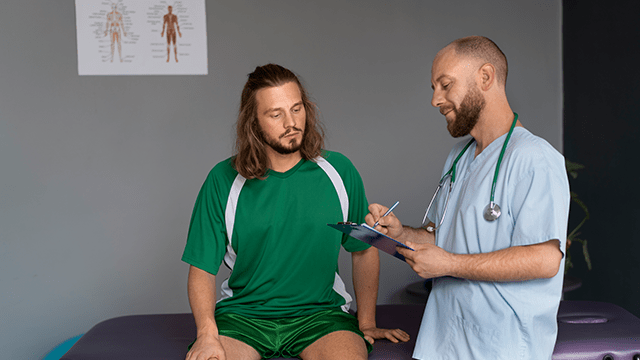
- Persistent or Worsening Pain: If your lower back pain persists despite performing exercises or if it worsens, it may be a sign of an underlying issue that requires professional evaluation. Persistent pain can indicate that your condition is not improving or that there may be a more serious problem.
- Acute Injury: If you experience a sudden injury or acute episode of pain, such as from lifting a heavy object, it is important to seek medical advice. Acute injuries may require immediate attention and may benefit from a different approach than routine exercises.
- New Symptoms: If you develop new symptoms such as numbness, tingling, or weakness in your legs or arms, consult a healthcare professional. These symptoms could indicate nerve involvement or other issues that require specialized treatment.
- Difficulty with Exercises: If you find it challenging to perform exercises correctly or experience significant discomfort, a physiotherapist can provide guidance and modify exercises to suit your needs. Professional assistance ensures that you are performing exercises safely and effectively.
- Medical Conditions: If you have pre-existing medical conditions or comorbidities, consult a healthcare professional before starting a new exercise program. Conditions such as osteoporosis, herniated discs, or spinal stenosis may require specific modifications or considerations.
- Lack of Improvement: If you have been consistent with your exercise routine but have not seen any improvement in your lower back pain, it may be time to seek professional help. A physiotherapist can assess your condition, provide a tailored treatment plan, and make adjustments as needed.
By recognizing these situations and seeking professional help when necessary, you can address any issues promptly and receive the appropriate care to support your recovery and overall well-being.
Conclusion
Managing and preventing lower back pain involves a multifaceted approach that includes understanding the causes, incorporating effective physiotherapy exercises, and maintaining healthy lifestyle habits. By following a well-rounded plan, you can significantly improve your back health and enhance your overall quality of life.
Understanding Lower Back Pain is the first step toward effective management. Recognizing the causes, such as poor posture, muscle imbalances, or injuries, allows you to tailor your approach and address the root of the problem. Educating yourself about the anatomy of the lower back and how it functions helps you to better understand how exercises and lifestyle changes impact your back health.
Top Physiotherapy Exercises are essential for addressing lower back pain. Incorporating exercises such as pelvic tilts, bridges, and hamstring stretches can help strengthen the muscles supporting your spine, improve flexibility, and reduce pain. Each exercise plays a role in enhancing spinal stability and promoting overall back health. Regularly performing these exercises, while adhering to proper form and gradually increasing intensity, can lead to significant improvements in your condition.
Incorporating Exercises into Your Daily Routine is crucial for long-term success. Establishing a consistent routine, setting realistic goals, and finding ways to stay motivated ensure that your exercise regimen becomes a natural part of your lifestyle. By making exercise a regular habit and tracking your progress, you can achieve better results and maintain your commitment to managing lower back pain.
Safety Considerations and Precautions are vital to prevent injury and ensure the effectiveness of your exercises. Avoiding common mistakes, such as incorrect form or overexertion, and knowing when to seek professional help can help you avoid setbacks and ensure that your exercise program is safe and beneficial.
Maintaining Long-Term Back Health involves adopting healthy lifestyle habits, optimizing ergonomics and posture, and balancing physical activity with rest. By integrating these practices into your daily life, you support your back health and reduce the risk of future pain.
In conclusion, managing lower back pain effectively requires a comprehensive approach that combines education, targeted exercises, and healthy lifestyle habits. By understanding the underlying causes, incorporating appropriate exercises, and maintaining a balanced routine, you can achieve lasting relief and improve your overall well-being. Consistency and commitment to your back health will lead to better outcomes and a more active, pain-free life.
FAQs (Frequently Ask Questions)
What causes lower back pain?
Lower back pain can be caused by a variety of factors, including poor posture, muscle imbalances, injuries, lack of physical activity, or repetitive strain. It can also result from conditions such as herniated discs, arthritis, or spinal stenosis. Understanding the root cause of your pain is important for choosing the right treatment and exercises.
How can physiotherapy exercises help with lower back pain?
Physiotherapy exercises can help reduce lower back pain by strengthening the muscles that support your spine, improving flexibility, and enhancing overall stability. These exercises target key muscle groups such as the core, hips, and lower back, helping to alleviate tension, reduce inflammation, and promote proper movement patterns.
What are the best exercises for lower back pain?
Some of the most effective physiotherapy exercises for lower back pain include pelvic tilts, bridges, hamstring stretches, knee-to-chest stretches, and bird dogs. These exercises focus on improving core strength, flexibility, and spinal stability, which are crucial for reducing pain and preventing future issues.
How often should I do physiotherapy exercises for lower back pain?
Consistency is key when it comes to managing lower back pain. Aim to perform your exercises 3-5 times a week, depending on your pain level and physical condition. Start with shorter sessions, and as you build strength and endurance, gradually increase the intensity and duration of your exercises.
What should I do if my pain worsens during exercise?
If you experience sharp or worsening pain during exercise, stop immediately. Pain may indicate that you’re performing the exercise incorrectly or that the exercise is too advanced for your current condition. It’s important to listen to your body and consult a physiotherapist if you experience persistent or increasing discomfort.
How can I stay motivated to do my exercises regularly?
To stay motivated, choose exercises you enjoy, set realistic goals, and track your progress. You can also exercise with a partner for accountability or reward yourself for reaching milestones. Keeping a positive attitude and varying your routine can help maintain your motivation over time.
How can I incorporate physiotherapy exercises into my daily routine?
To incorporate physiotherapy exercises into your routine, start by choosing a convenient time of day and scheduling your sessions in advance. Keep the sessions short at first, and gradually increase their length as you improve. Regularly doing a mix of strengthening, stretching, and mobility exercises can seamlessly fit into your lifestyle.
What are common mistakes to avoid when doing lower back exercises?
Some common mistakes include performing exercises with incorrect form, overexerting yourself, skipping warm-up and cool-down phases, and ignoring pain signals. Make sure to follow proper technique, progress gradually, and listen to your body to avoid injury and ensure effective results.
How can I maintain long-term back health?
Maintaining long-term back health involves regular exercise, a balanced diet, proper hydration, and good posture. Ensuring that your workstation is ergonomically designed and taking breaks to stretch or move can also help prevent strain. Additionally, managing stress and getting adequate sleep supports overall spinal health.
When should I seek professional help for lower back pain?
You should seek professional help if your lower back pain persists or worsens despite exercise, if you experience new symptoms like numbness or weakness, or if you have difficulty performing exercises correctly. Consulting a physiotherapist or healthcare professional can help you address underlying issues and receive personalized treatment.


